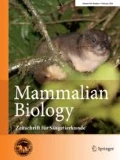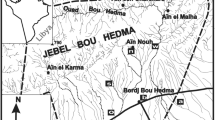Abstract
The winter activity of bats was studied in an area of Bavaria, Southern Germany, for seven consecutive years (2007–2013). Echolocation calls were recorded in known foraging areas between October and March of each winter, and bats were regularly seen on evenings with temperatures above +6°C, except for the period between mid-December and mid-February, when even bouts of warm weather did not appear to trigger foraging activity. Below +3 ° C no bats appeared in the foraging areas. The most frequently recorded species were Nyctalus noctula, Pipistrelluspipistrellus, Pipistrellus nathusii and Vespertilio murinus. Final buzzes indicating attempts to catch prey were recorded for these species even in December and February, which supports the idea that the bats were not only in search of water or just moving between roosts. Myotis species, on the other hand, which hibernate in roosts offering more constant temperature conditions, were not observed at all between mid-November and March. Further investigations have to show whether warmer winter evenings offer bats an opportunity for casual hunting or whether winter foraging expresses an urgent need for weak individuals.
Similar content being viewed by others
References
Avery, M.I., 1985. Winter activity of pipistrelle bats. J. Anim. Ecol. 54, 721–773.
Avery, M.I., 1986. The winter activity of noctule bats (Nyctalus noctula).J. Zool. 209, 296–299.
Berkova, H., Zukal,J., Rehak, Z., 2002. Flight activity of bats at the entrance of a natural cave. Bat Res. News 43, 76.
Daan, S., 1973. Activity during natural hibernation in three species of vespertilionid bats. Neth. J. Zool. 23, 1–71.
Dunbar, M.B., Whitaker, J.O., Robbins, L.W., 2007. Winter feeding by bats in Missouri. Acta Chiropterologica9 (1), 305–322.
Furmankiewicz,J., Gorniak, J., 2002. Seasonal changes in number and diversity of bat species (Chiroptera) in the Stolec mine (SW Poland). Przyr. Sud. Zach., Suppl. 2, 49–70.
Geluso, K., 2007. Winter activity of bats over water and along flyways in New Mexico. Southwestern Nat. 52 (4), 482–492.
Hays, G.C., Speakman,J.R., Webb, P.I., 1991. Why do brown long-eared bats (Plecotus auritus) fly in winter? Physiol. Zool. 65, 554–567.
Hope, P.R., Jones, G., 2012. Warming up for dinner: torpor and arousal in hibernating Natterer’s bats (Myotis nattereri) studied by radio telemetry. Journal of Comparative Physiology B 182, 569–578.
Johnson, J.S., Lacki, M.J., Thomas, S.C., Grider,J.F., 2012. Frequent arousals from winter torpor in Rafinesque’s big-eared bat (Corynorhinus rafinesquii). PLoS One 7 (11), e49754, https://doi.org/10.1371/journal.pone.0049754.
Johnson, S.A., Brack, V., Rolley, R.E., 1998. Overwinter weight loss of Indiana bats (Myotis sodalis) from Hibernacula subject to human visitation. Am. Midland Nat. 139, 255–261.
Kanuch, P., Janeckova, K., Kristin, A., 2005. Winter diet of the noctule bat Nyctalus noctula. Folia Zoologica 54 (1–2), 53–60.
Lausen, C.L., Barclay, R.M.R., 2006. Winter bat activity in the Canadian prairies. Can. J. Zool. 84, 1079–1086.
Liegl, C, 2004. Zweifarbfledermaus Vespertilio murinus. In: Meschede, A., Rudolph, B.U. (Ed.), Fledermäuse in Bayern. Ulmer Verlag, Stuttgart, pp. 296–304.
Meschede, A., Rudolph, B.U., 2004. Landesweite Auswertungen. In: Meschede, A., Rudolph, B.U. (Ed.), Fledermäuse in Bayern. Ulmer Verlag, Stuttgart, pp. 58–96.
Meschede, A., 2004. Rauhautfledermaus Pipistrellus nathusii. In: Meschede, A., Rudolph, B.U. (Ed.), Fledermäuse in Bayern. Ulmer Verlag, Stuttgart, pp. 280–290.
Meschede, A., Rudolph, B.U., 2010. 1985-2009: 25 Jahre Fledermausmonitoring in Bayern. Schriftenr. des Bayerischen Landesamtes für Umwelt. Bayerisches Lan-desamt für Umweltschutz, Augsburg.
Park, K.J., Jones, G., Ransome, R.D., 2000. Torpor, arousal and activity of hibernating greater horseshoe bats. Funct. Ecol. 14, 580–588.
Park, K.J., Jones, G., Ransome, R.D., 1999. Winter activity of a population of greater horseshoe bats (Rhinolophus ferrumequinum). J. Zool. Lond. 248, 419–427.
Parsons, K.N., Jones, G., Greenaway, F., 2003. Swarming activity of temperate zone microchiropteran bats: effects of season, time of night and weather conditions. J. Zool. 261, 257–264.
Ransome, R.D., 2002. Winter feeding studies on greater horseshoe bats. In: English Nature Research Reports No. 449. English Nature, Peterborough, pp. 1–47.
Ressl, F., 1967. Über das Vorkommen einiger winteraktiver Insekten im Bezirk Scheibbs (N.Ö.). Entomologisches Nachrichtenblatt 14, 85–87.
Rodrigues, L, Zahn, A., Rainho, A., Palmeirim, J., 2003. Contrasting the roosting behaviour and phenology of an insectivorous bat (Myotis myotis) in its southern and northern distribution ranges. Mammalia 67, 321–335.
Rudolph, B.U., 2004. Mopsfledermaus Barbastella barbastellus. In: Meschede, A., Rudolph, B.U. (Ed.), Fledermäuse in Bayern. Ulmer Verlag, Stuttgart, pp. 340–355.
Rudolph, B.U., Lichti, H., Liegl, C, Pichl, S., 2010. Verbreitung, status und erste Erken-ntnisse zum Verhalten und zurÖkologie derWeißrandfledermaus, Pipistrellus kuhlii (Kuhl, 1817), in Bayern. Nyctalus (N.F.) 15, 191–212.
Sachteleben,J., Rudolph, B.U., Meschede, A., 2004. ZwergfledermausPipistrellus pipistrellus. In: Meschede, A., Rudolph, B.U. (Ed.), Fledermäuse in Bayern. Ulmer Verlag, Stuttgart, pp. 263–275.
Sendor, T., Kugelschafter, K., Simon, M., 2000. Seasonal variation of activity patterns at a pipistrelle (Pipistrellus pipistrellus) hibernaculum. Myotis 38, 91–109.
Speakman, J.R., Racey, P.A., 1989. Hibernal ecology of the pipistrelle bat: energy expenditure, water requirements and mass loss, implications for survival and the function of winter emergence flights. J. Anim. Ecol. 58, 797–813.
Taylor, R.J., O’Neill, M.G., 1988. Summer activity patterns of insectivorous bats and their prey in Tasmania. Aust. Wildl. Res. 15, 533–539.
Thomas, D.W., 1995a. The physiological ecology of hibernation in vespertilionid bats. Symp. Zool. Soc. Lond. 67, 233–244.
Thomas, D.W., 1995b. Hibernating bats are sensitive to non-tactilehuman disturbance. J. Mammal. 76, 940–946.
Turbill, C.Geiser, F., 2008. Hibernation by tree roosting bats. J. Comp. Physiol. B. 178, 597–605.
Wermundsen, T., Siivonen, Y., 2010. Seasonal variation in use of winter roosts by five bat species in south-east Finland. Cent. Eur. J. Biol. 5, 262–273.
Whitaker Jr., J.O., Rissler, L.J., 1992. Winter activity of bats at a mine entrance in Vermillion County, Indiana. Am. Midland Nat. 127, 152–159.
Whitaker Jr., J.O., Rissler, L.J., 1993. Do bats feed in winter? Am. Midland Nat. 129, 200–203.
Zahn, A., Clauss, B., 2003. Winteraktivität des Abendseglers (Nyctalus noctula) in Südbayern. Nyctalus (N.F.) 9 (2), 99–104.
Zahn, A., Maier, S., 1997. Jagdaktivität von Fledermäusen an Bächen und Teichen. Zeitschrift fürSäugetierkunde 62, 1–11.
Zahn, A., Christoph, C, Christoph, L, Kredler, M., Reitmeier, A., Reitmeier, F., Schachenmeier, C, Schott, T., 2000. Die Nutzung von Spaltenquartieren an Gebäuden durch Abendsegler (Nyctalus noctula) in Südostbayern. Myotis 37, 61–76.
Zahn, A., Meschede, A., Rudolph, B.U., 2004. Abendsegler (Nyctalus noctula). In: Meschede, A., Rudolph, B.U. (Ed.), Fledermäuse in Bayern. Ulmer Verlag, Stuttgart, pp. 232–252.
Author information
Authors and Affiliations
Corresponding author
Rights and permissions
About this article
Cite this article
Zahn, A., Kriner, E. Winter foraging activity of Central European Vespertilionid bats. Mamm Biol 81, 40–45 (2016). https://doi.org/10.1016/j.mambio.2014.10.005
Received:
Accepted:
Published:
Issue Date:
DOI: https://doi.org/10.1016/j.mambio.2014.10.005




